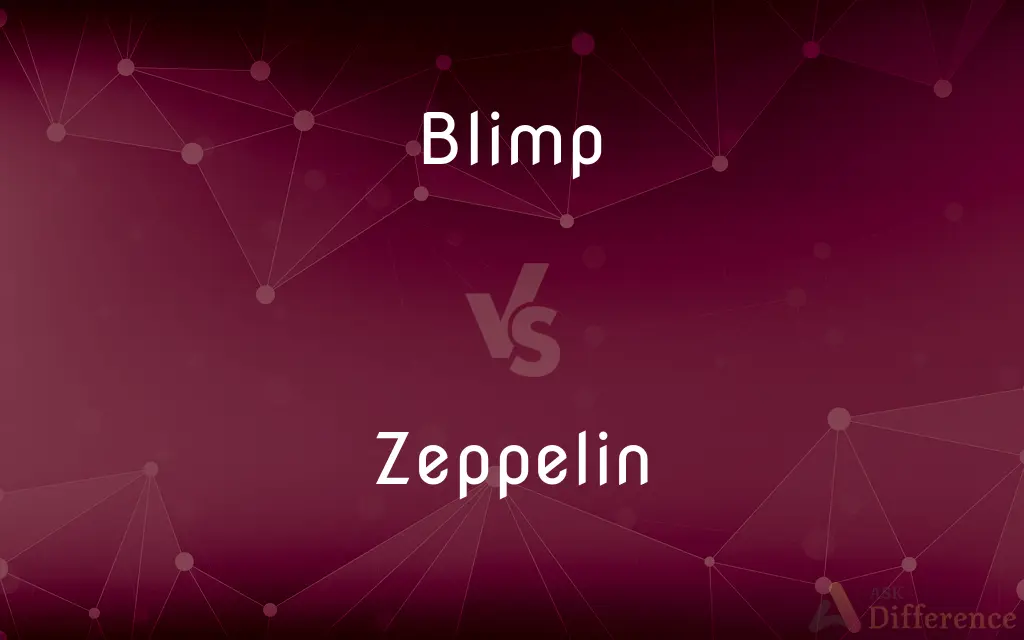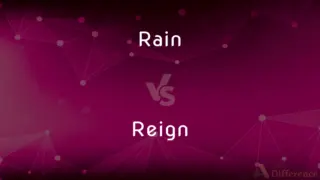Blimp vs. Zeppelin — What's the Difference?
By Tayyaba Rehman & Urooj Arif — Updated on April 27, 2024
Blimps are non-rigid airships with no internal framework, primarily used for advertising and surveillance, whereas Zeppelins, on the other hand, have a rigid framework supporting their shape, and historically served in passenger and military roles.

Difference Between Blimp and Zeppelin
Table of Contents
ADVERTISEMENT
Key Differences
Blimps feature a non-rigid structure, meaning they maintain their shape only when filled with gas, typically helium. This design makes them lighter and more flexible, suitable for tasks like aerial advertising and short surveillance missions. On the other hand, Zeppelins possess a rigid internal structure made of lightweight materials like aluminum, which allows them to be larger and carry more weight, thus suitable for long-distance travel and heavier payloads.
In terms of historical significance, blimps have been widely used, particularly by the U.S. Navy for patrol and reconnaissance duties during the 20th century. Zeppelins, however, gained fame through their pioneering roles in long-distance air travel and as bombers during World War I, highlighting their broader utility in commercial and military applications.
Operational efficiency sees blimps typically operated by a small crew and capable of vertical takeoffs and landings, making them ideal for operations in confined areas. Zeppelins require more extensive ground support and infrastructure due to their size and operational complexities, catering to different logistical needs.
From a passenger perspective, blimps are rarely used for carrying passengers, focusing more on observation and promotional activities. Zeppelins were renowned for their luxurious passenger accommodations during the early to mid-20th century, offering unique aerial travel experiences.
Today, blimps are commonly seen hovering over sports events for aerial coverage and advertising due to their maneuverability and low operational costs. Zeppelins are less common but have seen a resurgence in niche tourism and leisure sectors, offering scenic flights with historical allure.
ADVERTISEMENT
Comparison Chart
Structure
Non-rigid; no internal frame
Rigid; internal framework
Use Cases
Advertising, surveillance
Passenger transport, military
Operational Needs
Minimal ground support
Extensive ground support
Passenger Capacity
Typically none or very few
Can carry dozens of passengers
Historical Use
Primarily mid-20th century
Early 20th century prominence
Compare with Definitions
Blimp
A lighter-than-air aircraft without an internal structural framework.
The blimp hovered over the stadium, providing a live feed for the television broadcast.
Zeppelin
Contains a framework that maintains its shape.
The rigid structure of the Zeppelin allows it to carry heavier loads than a blimp.
Blimp
Operates with a helium-filled envelope.
The blimp needs its helium topped off before the next flight.
Zeppelin
Historically used for passenger and military transport.
Zeppelins were deployed as bombers in World War I before transitioning to commercial air travel.
Blimp
Often used in military and naval operations for reconnaissance.
Historically, blimps were deployed for coastal patrols during the war.
Zeppelin
Requires a larger ground crew and more infrastructure.
The Zeppelin's arrival necessitated a large ground crew for its docking and maintenance.
Blimp
Requires less ground support for operations.
The blimp was quickly prepared and launched from the small field.
Zeppelin
A type of rigid airship named after the German inventor Count Ferdinand von Zeppelin.
The Zeppelin became a symbol of air travel luxury in the early 20th century.
Blimp
Used mainly for advertising and aerial surveillance.
The company hired a blimp to fly their promotional banner across the city.
Zeppelin
Has seen a modern resurgence in leisure and tourism.
Modern Zeppelins offer scenic flights over historical cities and landscapes.
Blimp
A blimp, or non-rigid airship, is an airship (dirigible) without an internal structural framework or a keel. Unlike semi-rigid and rigid airships (e.g.
Zeppelin
A Zeppelin is a type of rigid airship named after the German inventor Count Ferdinand von Zeppelin (German pronunciation: [ˈt͡sɛpəliːn]) who pioneered rigid airship development at the beginning of the 20th century. Zeppelin's notions were first formulated in 1874 and developed in detail in 1893.
Blimp
A pompous, reactionary, ultranationalistic person.
Zeppelin
A rigid airship having a long cylindrical body supported by internal gas cells.
Blimp
A nonrigid, buoyant airship.
Zeppelin
Alternative case form of Zeppelin
Blimp
(Derogatory) An obese person.
Zeppelin
A dirigible balloon of the rigid type, consisting of a cylindrical trussed and covered frame supported by internal gas cells, and provided with means of propulsion and control. It was first successfully used by Ferdinand Count von Zeppelin.
Blimp
(Slang) To become very fat. Often used with out
He's really blimped out since he got that desk job.
Zeppelin
German inventor who designed and built the first rigid motorized dirigible (1838-1917)
Blimp
(aviation) An airship constructed with a non-rigid lifting agent container.
Zeppelin
A large rigid dirigible designed to carry passengers or bombs
Blimp
(by extension) Any large airborne inflatable.
Blimp
(slang) An obese person.
Blimp
A person similar to the cartoon character Colonel Blimp; a pompous, reactionary British man.
Blimp
A soundproof cover for a video camera.
Blimp
To expand like a blimp or balloon; to become fat.
After college, she started blimping and could no longer wear her favorite little black dress.
Over a few years the software had blimped into typical bloatware.
Blimp
(transitive) To fit (a video camera) with a soundproof cover.
Blimp
Any elderly pompous reactionary.
Blimp
A small nonrigid airship used for observation or as a barrage balloon.
Blimp
Any elderly pompous reactionary ultranationalistic person (after the cartoon character created by Sir David Low)
Blimp
A small nonrigid airship used for observation or as a barrage balloon
Common Curiosities
Can blimps carry passengers like Zeppelins?
Typically, blimps do not carry passengers and are used for other purposes like advertising, whereas Zeppelins can carry multiple passengers.
What kind of gas is used in blimps and Zeppelins?
Both blimps and Zeppelins primarily use helium, though historically, Zeppelins used hydrogen which is highly flammable.
What is the main structural difference between a blimp and a Zeppelin?
Blimps are non-rigid airships without internal frameworks, while Zeppelins have a rigid internal structure.
Why are blimps more commonly used for advertising compared to Zeppelins?
Blimps are more frequently used for advertising due to their lower operational costs, easier maneuverability, and ability to hover in one place, which is advantageous for capturing public attention at events.
How do the costs of operating a blimp compare to those of a Zeppelin?
Operating a blimp generally costs less than operating a Zeppelin. This is due to the simpler structure and smaller size of blimps, which require less maintenance and fewer resources for takeoff, landing, and operation.
What led to the decline in the use of Zeppelins for passenger transport?
The decline in Zeppelin usage for passenger transport was largely due to the catastrophic Hindenburg disaster in 1937, which raised safety concerns, and the advancement of heavier-than-air aircraft technology which proved more efficient and safer.
What advancements in technology have impacted the use of blimps and Zeppelins?
Advances in materials technology have allowed for safer and more efficient designs, particularly in the use of helium instead of hydrogen. Additionally, advancements in aviation technology have generally favored heavier-than-air craft, impacting the usage of both blimps and Zeppelins.
Are blimps or Zeppelins faster?
Zeppelins are typically faster than blimps due to their larger size and more powerful engines, making them better suited for longer distances.
What are the safety records of blimps versus Zeppelins?
Blimps generally have a better safety record compared to Zeppelins. This is partly because blimps are filled with non-flammable helium, whereas historical Zeppelins often used hydrogen, which is flammable.
Can Zeppelins be used for the same purposes as blimps, such as surveillance?
While Zeppelins can technically be used for surveillance, their larger size and higher operating costs make them less practical for such roles compared to blimps, which are more commonly used for these purposes.
How do the operational requirements of blimps and Zeppelins differ in terms of crew size?
Blimps usually require a smaller crew, often just a pilot and one or two crew members, due to their simpler operations and smaller size. Zeppelins, being larger and more complex, require a larger crew for operations and maintenance.
Are there any modern uses of Zeppelins that differ from historical uses?
Modern uses of Zeppelins have shifted towards niche areas like luxury tourism, offering scenic flights, unlike their historical roles in long-distance travel and military operations, reflecting changes in both technology and market demands.
What types of gases are filled in blimps and Zeppelins, and why?
Both blimps and Zeppelins are typically filled with helium, a non-flammable and lighter-than-air gas. Historically, Zeppelins used hydrogen, which provided more lift but was highly flammable.
Share Your Discovery

Previous Comparison
Rain vs. Reign
Next Comparison
Missus vs. MissisAuthor Spotlight
Written by
Tayyaba RehmanTayyaba Rehman is a distinguished writer, currently serving as a primary contributor to askdifference.com. As a researcher in semantics and etymology, Tayyaba's passion for the complexity of languages and their distinctions has found a perfect home on the platform. Tayyaba delves into the intricacies of language, distinguishing between commonly confused words and phrases, thereby providing clarity for readers worldwide.
Co-written by
Urooj ArifUrooj is a skilled content writer at Ask Difference, known for her exceptional ability to simplify complex topics into engaging and informative content. With a passion for research and a flair for clear, concise writing, she consistently delivers articles that resonate with our diverse audience.












































